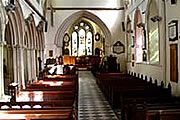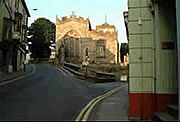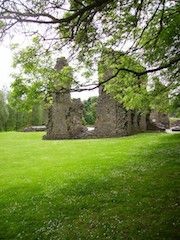Churches and Chapels

Among the parish churches of Haverfordwest three stand out visually. Anyone arriving from the east might notice the tower of St Thomas’s before catching sight of the castle itself. It stands at the edge of the hill on the south side of the town, breaking the skyline. St Mary’s, with a clock in its stubby tower, is an inescapable focal point, closing off the view up High Street. And although St Martin’s is a little hidden away, its slender spire is conspicuous from many angles.
The fourth church, St David’s, pertains to the suburb of Prendergast which was not absorbed into Haverfordwest until 1833. All four belong to the town’s first 100 years. That dedicated to St Martin of Tours is the original place of worship, a stone’s throw from the castle gatehouse (long since demolished). St Mary’s church came next, reflecting the shift in the town centre. St David’s and St Thomas à Becket were also in place before 1210.
What is most visible about the churches today, however, is by no means always original. There is evidence that St Martin’s was rebuilt in the 14th century, and it was certainly heavily restored in the 19th century. The spire is a replacement and dates from about 1870. St Thomas’s church too was extensively restored by the Victorians, and St David’s was entirely rebuilt but for its tower.

See: St Marys Church
St Mary’s, the biggest church and historically the richest (it was the chosen church of the gentry), is architecturally the most rewarding. The building contains 13th century work of outstanding quality, also a wealth of monuments of more recent date and a fine early 18th century organ. St Mary’s too had a spire once. It was removed in 1802, since Lady Kensington feared it might fall on her house.

There is a fifth (but deconsecrated) church in the 13th century Augustinian priory at the south end of Quay Street. The picturesque ruin has been expertly preserved and is adequately explained and signposted. Sadly it is among the least appreciated of the town’s treasures.

The town is still rich in chapels although less so than formerly. It is recorded that in 1900 there were 10 Nonconformist places of worship in Haverfordwest. Of those that remain, Albany (which was rebuilt in 1841, Congregationalist) was designed by William Owen in an unexpected Gothic style. Tabernacle (rebuilt 1874, Congregationalist) and Ebenezer (rebuilt 1889, Calvinistic Methodist) are decidedly but very differently Classical, Bethesda (rebuilt 1880, Baptist) is massively Romanesque.

